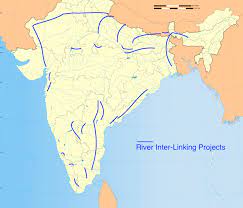CURRENT AFFAIRS
Get the most updated and recent current affair content on Padhaikaro.com
NIRA
- Vaid's ICS, Lucknow
- 22, Dec 2021

Why in News?
The Central government is working on the establishment of an exclusive body to implement projects for linking rivers- To be called the National Interlinking of Rivers Authority (NIRA).
Functions of NIRA:
- It is expected to take up both inter-State and intra-State projects.
- It will also make arrangements for generating funds, internally and externally.
About National River Linking Project (NRLP):
The NRLP formally known as the National Perspective Plan, envisages the transfer of water from water ‘surplus’ basins where there is flooding to water ‘deficit’ basins where there is drought/scarcity, through inter-basin water transfer projects.
Significance: It is designed to ease water shortages in western and southern India while mitigating the impacts of recurrent floods in the eastern parts of the Ganga basin.
ILR Projects in India:
As of now, six ILR projects — the Ken-Betwa, Damanganga- Pinjal, Par-Tapi-Narmada, Manas-Sankosh-Teesta-Ganga, Mahanadi-Godavari and Godavari-Cauvery (Grand Anicut) — have been under examination of the authorities.
With regard to the peninsular rivers, the Centre has chosen to focus on the Godavari-Cauvery link than the earlier proposal to link the Mahanadi-Godavari-Krishna-Pennar-Cauvery rivers.
Issues and Concerns:
Interlinking of rivers is a very expensive proposal. It will adversely affect land, forests, biodiversity, rivers and the livelihood of millions of people.
- Interlinking of rivers will lead to destruction of forests, wetlands and local water bodies,which are major groundwater recharge mechanisms.
- It causes massive displacement of people. Huge burden on the government to deal with the issue of rehabilitation of displaced people.
- Due to interlinking of rivers, there will be decrease in the amount of fresh water entering seas and this will cause a serious threat to the marine life.
Facts for Prelims:
Albino Indian Flapshell turtle:
- A rare species of Albino Indian Flapshell turtle was recently sighted by Mountaineers in Sirnapalli forest in Telangana’s Nizamabad.
- The Indian flapshell turtle is commonly found in South Asian countries like Pakistan, Sri Lanka, India, Nepal, Bangladesh and Myanmar.
- The rare yellow color of the turtle may be due to the lack of a pigment called tyrosine present in high amounts in reptiles.
- A genetic mutation or possible congenital disorder is likely responsible for the lack of tyrosine.
- Indian flapshell turtles are typically are only 9 to 14 inches (22 centimeters to 35 centimeters) long, and like to eat frogs, snails and aquatic vegetation.
Conservation Status:
- IUCN Red List: Vulnerable.
- CITES: Appendix II.
- Wildlife (Protection) Act, 1972: Schedule I.